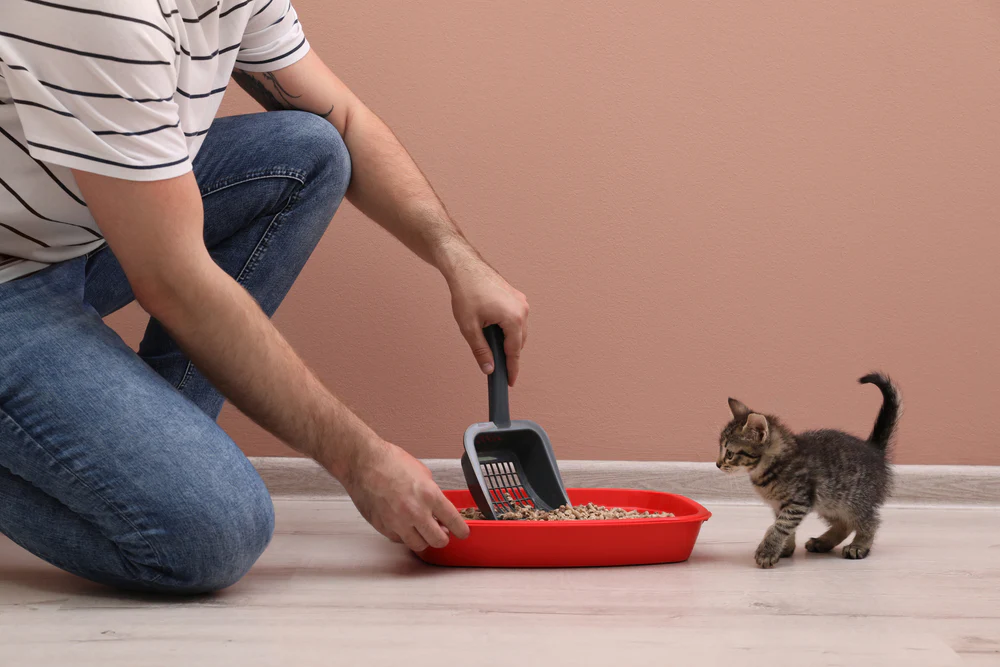Maintaining a clean and fresh litter box is essential for your cat’s well-being. A properly cared-for litter box not only prevents odours but also encourages consistent litter box use and reduces the risk of behavioural issues. To get to know your feline friend better, we need to understand cat behaviour.
Here’s everything you need to know about proper litter box maintenance to keep your cat happy and healthy.
-
Choose the Right Litter
Selecting the ideal litter is a crucial step in ensuring your cat feels comfortable using their box. Cats are known for their picky preferences, so it may take some trial and error to find the perfect fit. Common options include:
- Clumping Clay Litter: Easy to scoop and effective at odour control.
- Silica Gel Crystals: Absorbs moisture and controls smells with minimal mess.
- Pine Pellets: An eco-friendly option with natural odour-neutralising properties.
Consider factors like dust levels, texture, and scent when choosing a litter. Many cats prefer unscented varieties, as their heightened sense of smell makes strong fragrances unappealing. Additionally, ensure the litter is soft on their paws, particularly for kittens or senior cats.
When choosing cat litter, we should choose the healthiest, odourless and comfortable one for your cat. At this point, Catvenience Wood Pellets Cat Litter will be the best favour you will do to your cat.
-
Provide Enough Litter Boxes
The general rule for litter boxes is one per cat, plus an extra. For instance, a household with two cats should have at least three boxes. This reduces territorial disputes and ensures that each cat has access to a box when needed.
Placement Tips for Litter Boxes:
- Spread Them Out: Position the boxes in different parts of your home, especially if you live in a multi-story house. This ensures accessibility and prevents cats from being forced to share confined spaces.
- Quiet and Private Areas: Cats value their privacy, so place boxes in low-traffic, calm areas. Avoid noisy appliances or places frequented by children or other pets.
By offering the right number and type of boxes, you minimize accidents and encourage healthy habits.
Proper litter box care is not just about keeping your home clean- it’s a vital part of ensuring your cat feels secure and comfortable. If you don’t want to deal with common litter box problems, stay tuned for excellent suggestions!
-
Daily Scooping: The Foundation of Litter Box Care
Daily scooping is a simple yet vital habit for keeping the litter box fresh and odour-free. Cats are naturally clean animals, and a neglected box may deter them from using it altogether. Here’s how to scoop like a pro:
- Use a sturdy scooper to remove clumps and solid waste every day.
- Dispose of waste in a sealed, leak-proof bag to contain odours.
- Stir the remaining litter to ensure even distribution and reduce hotspots of moisture or scent.
Regular scooping doesn’t just control odours; it also helps you monitor your cat’s health. Changes in waste size, frequency, or consistency can be early indicators of potential health issues.
-
Deep Cleaning and Litter Replacement
Every few weeks, it’s essential to give the litter box a thorough clean to maintain a sanitary environment. Follow these steps for a spotless reset:
- Empty the box entirely and dispose of old litter in a sealed bag.
- Wash the box with mild, unscented soap and warm water. Avoid using harsh chemicals, as their lingering odours may discourage your cat from using the box.
- Rinse and dry the box thoroughly to prevent moisture buildup, which can lead to bacterial growth.
- Add fresh litter, ensuring an even layer of at least 5–7 cm for optimal absorption and comfort.
Regular deep cleaning not only prevents odours but also extends the life of the litter box by minimising stains and wear.
-
Liners and Mats: Keeping Your Home Clean
Litter box liners and mats can make a world of difference in simplifying your cleaning routine:
- Liners: These create a barrier between the litter and the box, making it easier to remove soiled litter during replacements. Choose durable liners that resist tearing from scratching.
- Mats: Placed outside the box, mats trap stray litter from your cat’s paws, keeping it from being tracked around your home. Opt for non-slip mats with a soft texture for your cat’s comfort.
With these tools, maintaining a tidy and welcoming litter box area becomes more manageable, ensuring both you and your cat enjoy a cleaner living space.
By incorporating these practices into your routine, you’ll create an environment where your cat feels comfortable and your home stays fresh!
-
Refreshing the Litter
Adding a thin layer of fresh litter between full cleanings helps maintain a clean surface for your cat while controlling odours. Here’s how to keep the box consistently inviting:
- Monitor Regularly: Check for signs of clumping or lingering odours. The frequency of refreshing depends on your cat’s habits and the type of litter you use.
- Top Up Sparingly: Avoid overfilling the box. A light layer (around 1–2 cm) is usually enough to restore freshness without wasting litter.
- Mix Gently: Stir the fresh litter into the existing layer to maintain an even texture and prevent clumps from hardening at the bottom.
Regularly refreshing the litter ensures your cat always has a clean and pleasant surface, encouraging consistent use.

